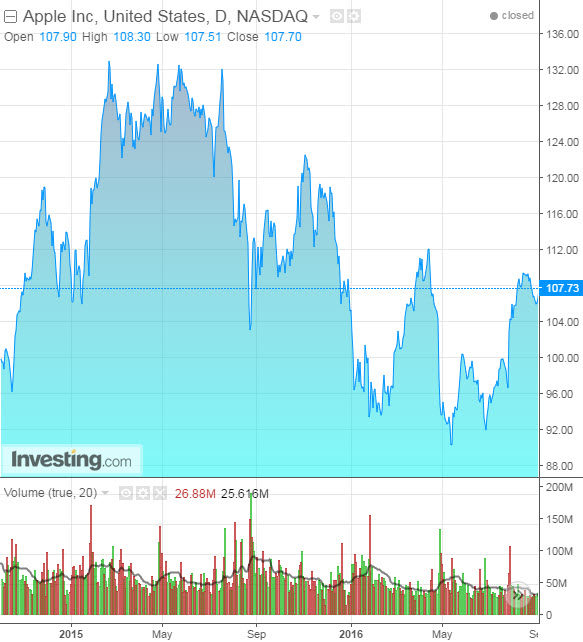by Clement Thibault

Since April 2015, the last time Apple’s (NASDAQ:AAPL) stock hit an all-time high at $134, the company has had it pretty rough. Growth prospects haven’t panned out, and investors are now unsure of the company's true value, as is evident by the drastic change in the stock price over the past 17 months—from $134, down to $90, and back up to today's $107 in anticipation of the newest iPhone release in San Francisco, at 10:00am Pacific time.
Net sales across the company have been less than stellar this year, to say the least. For the first three quarters of FY16 that total is $168.7B, down 7.4% from FY15's $182.2B for the same period.
The numbers for the iPhone itself, which amounted to 65% of Apple’s total sales during the last fiscal year, have been even more disappointing, with sales decreasing 12%—from $122.8B to $108.5B —over the same period.
The only line of business from among Apple’s 4 segments—iPhone, iPad, Macs, and Services—that’s still growing is the services division, increasing 22%, from $14.8B to $18B during the first three quarters of FY 16 compared to FY 15, thereby rescuing Apple from completely failing grades on its last earnings reports. However, it should be noted that the growth in services is primarily a function of revenue from the Appstore and AppleCare programs, both of which are tied to Apple's physical products. So if the number of iPhones drop too much, causing the user base to shrink, services could take a future hit to its own growth.
As for the soon-to-be released iPhone 7, markets aren’t expecting anything groundbreaking, which is good news for Apple's current valuation since it offers some welcome room for a possible upside surprise. At its current low P/E ratio of 12.5, there’s no big risk in owning Apple, since the company is still expected to top $200B in annual revenues while continuing to hold $200B in cash.
Recent dips to the company’s share price—bringing it down to the low $90s—lasted only a matter of days before it returned to the $100 mark. Low expectations also work in the stock's favor, since any excitement today's iPhone release manages to generate will positively affect the stock price. An achievable, additional 25% could generate new highs, leaving ample room for a nice rally.
Looking out just a bit, the first days of iPhone 7 sales post-release will also be important for the company. When the iPhone 6 was introduced in 2014, 10 million devices were sold within the first three days the device was available, a record broken just a year later by the iPhone 6s, when 13 million devices were sold over the same time period. The bigger problem for Apple is that as the number of post-launch days increase, the cachet of its devices diminishes, reducing the perception of exclusivity which early adopters relish.
That’s likely the case for each subsequent iPhone iteration as well. In the aggregate, Apple devices are becoming much more like any other smartphone, which can also cast a negative light on the high price of each of Apple’s numerous products.
For now, though brand loyalty among Apple customers is light years ahead of the user sentiment generated by products of chief rival Samsung (KS:005930). According to an RBC Capital Markets survey, over 83% of iPhone owners intend to stay with Apple for future upgrades, while only 63% of Samsung customers report the same intention.
So here’s the bottom line: given Wall Street's low expectations for Apple and the iPhone 7, the company doesn’t need to hit a home run today. Markets seem to have come to terms with another year of status quo performance as far as the company, its products and its share price are concerned.
That sounds like good news. But giving Apple a pass this year significantly increases the pressure longer-term. With the iPhone 8 release rumored to already be scheduled for next year at this time in order to coincide with the tenth anniversary of the iPhone itself, all of the company’s eggs may be ending up in one basket. Unless Apple plays its hand perfectly going forward, the next release could unintentionally be destructive for the brand, the product and the company.
